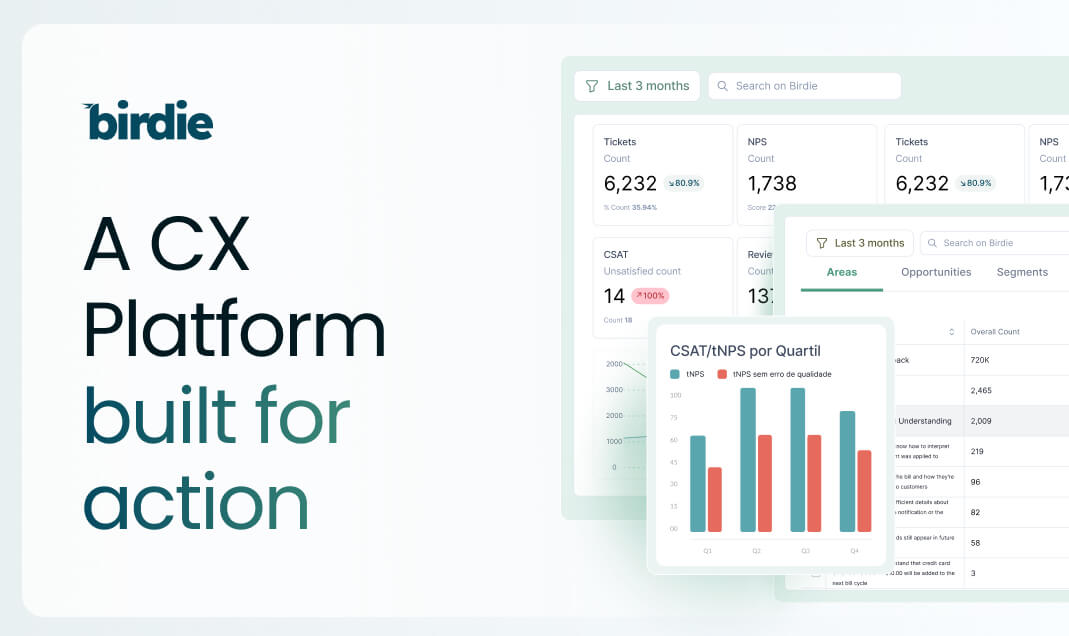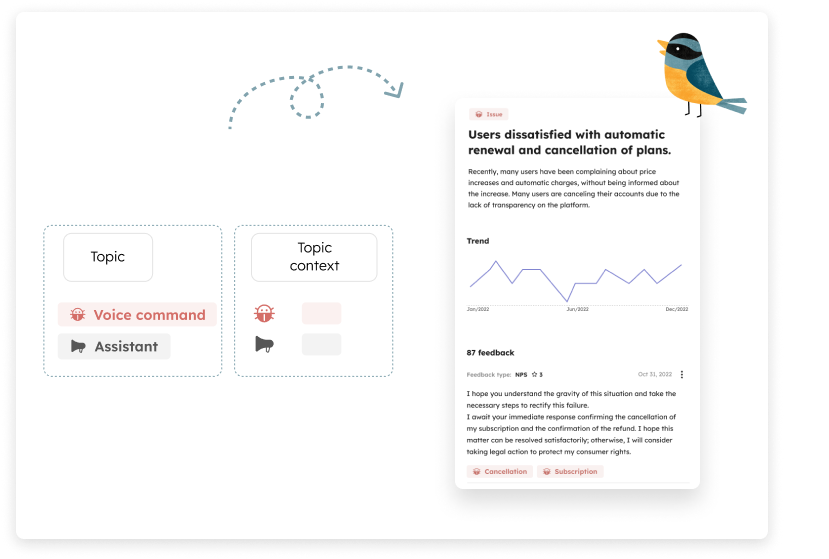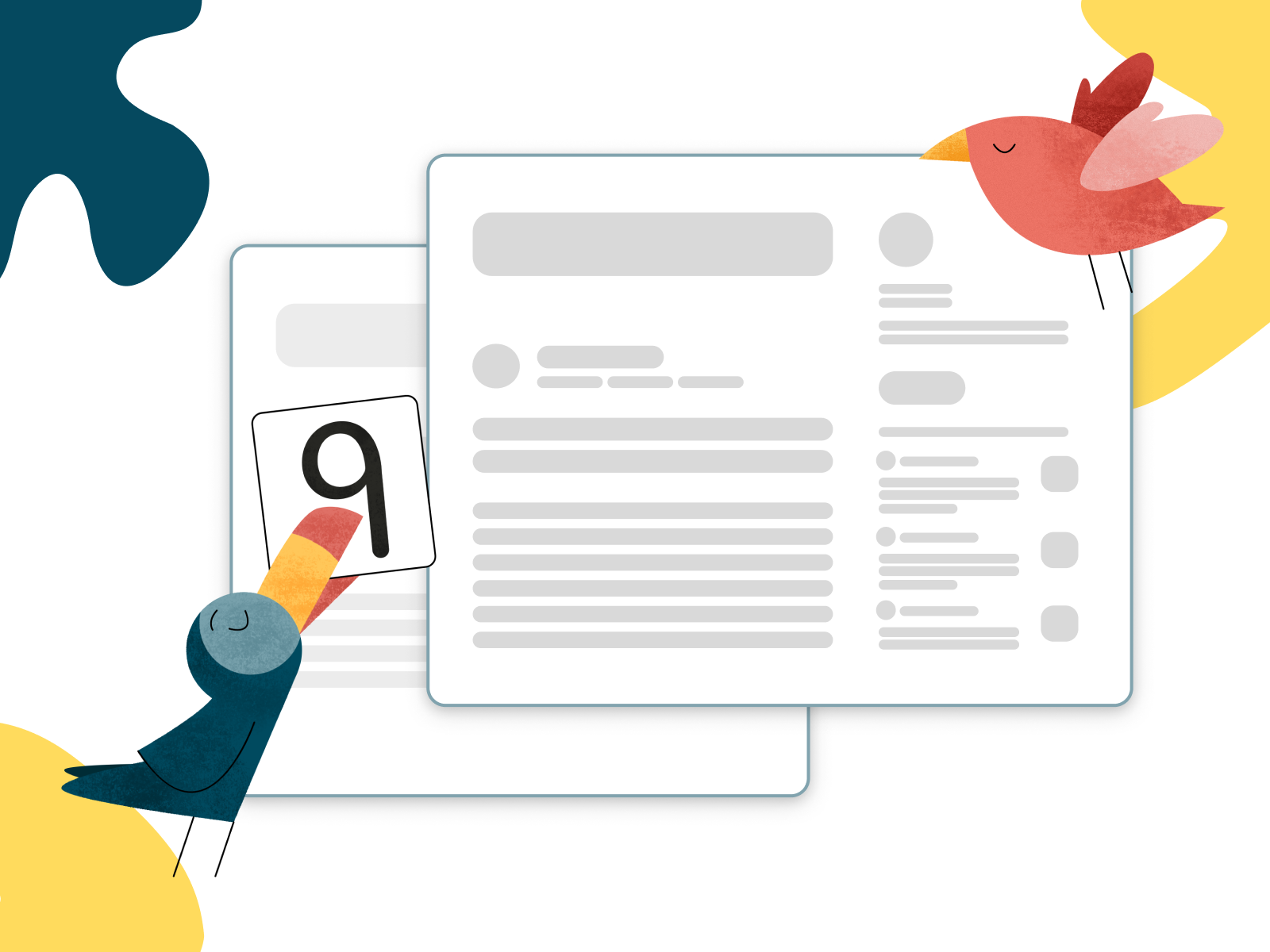
A little over a year ago, I wrote about how to use customer feedback to make better product decisions and improve our product intuition as Product Managers. That article was the fundamental idea behind Birdie and still expresses well our core value proposition of centralizing a myriad of customer feedback sources and using Artificial Intelligence to easily extract insights over this data, to help Product Managers, Designers, CX Managers, etc. scale the process of uncovering and understanding customer insights.
The road of a startup is full of ups and downs, new discoveries, and, most importantly, new learnings, and at Birdie this is no different. After a year of working side by side with dozens of customers and design partners and talking with uncountable product professionals to understand how to better help them, we found an interesting opportunity that tackles two very important metrics for almost all companies: customer satisfaction and support cost.
Once upon a time..
The funny thing behind this story is that, at least for me, all this desire to help product companies leverage customer feedback started with this exact problem of increasing customer satisfaction and decreasing support tickets. Back in 2018 I was leading product management in a Marketing Automation SaaS scale-up and we had an objective of increasing our NPS. I will not get into the discussion of the validity of using NPS as a loyalty metric, but let's agree on two things: 1) NPS helps us measure and understand customer satisfaction and 2) NPS is a lagging indicator.
Given the NPS metric's characteristics, we used the NPS survey to understand the macro problems our customers were reporting. Then we deep dive into our support tickets to understand these problems and find actionable opportunities. Why support tickets? Because it is the easiest way to deeply understand the issues our users are facing with our product. Usually, when a user struggles with something (if they don't just give up) they do one of the three things: 1) Click around the product trying to figure out how to solve the problem, 2) Try to find educational materials like forums or help center articles, or 3) Get in touch with the support. Of course, we can use tools to analyze user behavior or help center usage, but support is usually a gold mine of user perceptions, questions, and requests, and that is why we focus on this alternative.
By analyzing support interactions, it is easier to understand the main issues our customers are facing, their doubts, and expectations. This helps us formulate hypotheses about how to fix each problem. This level of granularity is pretty hard to get in satisfaction surveys like NPS. In this type of survey, we usually just receive broad feedback like "your Dashboards sucks" or, at best, something like "I want more flexibility to create charts". This is why the combination of satisfaction surveys and support analysis is so powerful, because in one source we can understand how each problem is affecting customer satisfaction, and in another, we can understand why and how it is happening.
Another interesting side effect of this approach was that we discovered a ton of opportunities to reduce support costs. This occurs because the primary efforts of the CX team to minimize support tickets focused more on automating the tasks of support agents, such as automated chat or pre-defined responses, rather than directly addressing the root cause of the initial issue. Knowing that we discovered many new opportunities to make support deflection, solving the root cause of the problem by improving user experience and the product itself. Doing that, even if it was not the goal, our customer satisfaction metrics would start to go up. In other words, it's a win-win, less cost for the company, and more happy customers. What a deal!
But, unfortunately, the reality is not all roses. Although this process makes complete sense, operationalizing this was hard and very time-consuming. 6 years ago we did everything manually by splitting all the support tickets by each Product Manager scope reading every single support ticket, one by one, and classifying them into customer problem themes in Google Sheets. You can argue that usually support agents already do some sort of classification. However, in my experience, this classification is vague and doesn't help product teams to really understand what is happening, and we wish way more details. It was painful but it was worth it. For some problems, we were able to reduce 100% of the tickets, and the global NPS increased by more than 20 points in less than one year.
Since then, I have been wondering if it is possible to implement a process like this without all the manual effort to analyze satisfaction surveys and especially support tickets. That's when I met Birdie, who was creating a product in this same problem space. In the last two years, we have been working insanely hard to figure out the best way to deliver product teams a tool to help them better explore qualitative data. We want to make customer feedback shine inside product companies, and currently, this data is, at best, treated as a second-class citizen. Unfortunately, it is so hard to get access to this kind of information and extract something valuable at scale that people tend to ignore it.
The next big thing
After partnering with many Product Operations Managers and CX Managers from some of the very best product companies in the world we started to see the same pattern over and over again. Companies want to increase customer satisfaction but don't know how to do it properly. At the same time they are spending a lot of money on customer support, but what happens inside these tickets is a big blind spot for the product teams. That was the moment where Birdie's methodology, our way of thinking and making things happen, got into the field.
After multiple iterations of our own methodology to help our customers increase their customer satisfaction and decrease support tickets, we finally arrived at a simple but effective 4-step process.
Step 1: deliver core value
The first step is to deliver our core value in practice, allowing product professionals to easily access all customer feedback in a single place. We put together support tickets, NPS surveys, CSAT surveys, app reviews, customer forums, etc., and enrich all these customer feedback pieces with AI classifications and metadata to enable powerful segmentations. At the end of this step our customers are able, for example, to search by a certain subject of interest, see and quantify all original feedback that mentions this subject, analyze trends, summarize data to easily digest large amounts of information, and even use a conversational interface to make questions about their customers.Â
Step 2: identify areas of interest
The second step is to identify areas of interest. An area of interest is a scope where each product team is focused. Could be a product (e.g. Credit Card), a feature (e.g. Statement), a customer journey (e.g. Onboarding), or a segmentation (e.g. Power Users). For steps 1 and 2 we usually heavily partner with Product Operations areas inside our customers to better execute these phases. Once we have identified the main areas of interest we can associate these areas with each Product Manager, for example, creating a personalized experience for them and helping them understand what the customer perceptions about these areas are.
Step 3: manage issues related to the areas
Once we have created areas of interest, the third step is to identify and manage issues related to each of these areas that can become opportunities to impact customer satisfaction and support tickets. To do that we use our AI models to analyze and quantify customer problems mentioned in the customer feedback database. We also can estimate the impact of each of these potential opportunities to improve customer satisfaction (usually measured by NPS) and reduce support costs by reducing the number of tickets created, and not just automatizing the support responses. Every user can take a deep dive into these opportunities and analyze trendlines, summaries, quantifications, and, of course, read the real voice of the customer.
Step 4: prioritize opportunities
The fourth and final step is to prioritize opportunities and use, all of the information available inside and outside Birdie. We can track prioritized opportunities inside our personalized dashboards, by doing this each PM can track in almost real-time the impact of product initiatives over these opportunities. Simplifying the process of attributing the impact of a particular product enhancement, aimed at reducing support tickets, to the overall metric. This is how we transform qualitative data into actionable information, Product Managers can use that to drive product improvements with real business impact and even as business KPIs.
As we know, shipping a new product or feature is just the beginning. For each opportunity we prioritize and act on, we will probably discover new problems to tackle and areas of improvement. With that, this 4-step cycle starts again, and we can identify new issues and even new areas of interest. The beauty about this entire process is that now it is finally easy to really listen to each of our customers, deep dive to identify the main pain points, and act on them. Artificial Intelligence is here to help us create better products and improve our processes in a way that was just a dream before, and Birdie is here to enable product companies to easily use all these new technologies and become even more successful.

Request demo








